Improved Mechanical and Electrochemical Properties of XNBR Dielectric Elastomer Actuator by Poly(dopamine) Functionalized Graphene Nano-Sheets
Abstract
:1. Introduction
2. Experimental
2.1. Raw Materials
2.2. Modification of GNS by PDA Self-Oxidative Polymerization
2.3. Preparation of XNBR Dielectric Composites Via Latex Mixing
2.4. Characterization Methods
3. Results and Discussion
3.1. Preparation of GNS-PDA Nano-Sheets
3.2. Microstructure and Mechanical Properties of XNBR Dielectric Composites
3.3. Dielectric and Electromechanical Properties of XNBR Dielectric Composites
4. Conclusions
Supplementary Materials
Author Contributions
Acknowledgements
Conflicts of Interest
References
- Madsen, F.B.; Daugaard, A.E.; Hvilsted, S.; Skov, A.L. The current state of silicone-based dielectric elastomer transducers. ACS Macro. Lett. 2016, 5, 1196–1200. [Google Scholar] [CrossRef]
- Hu, W.; Ren, Z.; Li, J.; Askounis, E.; Xie, Z.; Pei, Q. New dielectric elastomers with variable moduli. Adv. Funct. Mater. 2015, 25, 4827–4836. [Google Scholar] [CrossRef]
- Jang, Y.; Hirai, T. A control method for triblock copolymer actuators by nano-lamellar pattern. Soft Matter 2011, 7, 10818–10823. [Google Scholar] [CrossRef]
- Yin, G.; Yang, Y.; Song, F.; Renard, C.; Dang, Z.M.; Shi, C.Y.; Wang, D. Dielectric elastomer generator with improved energy density and conversion efficiency based on polyurethane composites. ACS Appl. Mater. Interfaces 2017, 9, 95237–95243. [Google Scholar] [CrossRef] [PubMed]
- Ji, X.; Haitami, A.E.; Sorba, F.; Rosset, S.; Nguyen, G.T.M.; Plesse, C.; Vidal, F.; Shea, H.R.; Cantin, S. Stretchable composite monolayer electrodes for low voltage dielectric elastomer actuators. Sens. Actuat. B Chem. 2018, 261, 135–143. [Google Scholar] [CrossRef]
- Poulin, A.; Rosset, S.; Shea, H.R. Printing low-voltage dielectric elastomer actuators. Appl. Phys. Lett. 2015, 107, 836–839. [Google Scholar]
- Tang, C.; Li, B.; Zou, C.; Chen, H. Voltage-induced wrinkle performance in a hydrogel by dielectric elastomer actuation. Polymers 2018, 10, 697. [Google Scholar] [CrossRef]
- Zhang, F.; Li, T.; Luo, Y. A new low moduli dielectric elastomer nano-structured composite with high permittivity exhibiting large actuation strain induced by low electric field. Compos. Sci. Technol. 2018, 156, 151–157. [Google Scholar] [CrossRef]
- Kim, J.Y.; Kim, H.; Kim, T.Y.; Yu, S.; Ji, W.S.; Jeong, T.; Song, S.; Min, J.B.; Han, I.; Jung, D. A chlorinated barium titanate-filled polymer composite with a high dielectric constant and its application to electroluminescent devices. J. Mater. Chem. C. 2013, 1, 5078–5083. [Google Scholar] [CrossRef]
- Gu, L.; Wang, T.; Zhang, W.; Liang, G.; Gu, A.; Yuan, L. Low-cost and facile fabrication of titanium dioxide coated oxidized titanium diboride-epoxy resin composites with high dielectric constant and extremely low dielectric loss. RSC Adv. 2013, 3, 7071–7082. [Google Scholar] [CrossRef]
- Wang, B.; Liu, L.; Liang, G.; Yuan, L.; Gu, A. Boost up dielectric constant and push down dielectric loss of carbon nanotube/cyanate ester composites via gradient and layered structure design. J. Mater. Chem. A. 2015, 3, 23162–23169. [Google Scholar] [CrossRef]
- Grabowski, C.A.; Koerner, H.; Meth, J.S.; Dang, A.; Hui, C.M.; Matyjaszewski, K.; Bockstaller, M.R.; Durstock, M.F.; Vaia, R.A. Performance of dielectric nanocomposites: Matrix-free, hairy nanoparticle assemblies and amorphous polymer-nanoparticle blends. ACS Appl. Mater. Interfaces 2014, 6, 21500–21509. [Google Scholar] [CrossRef] [PubMed]
- Chen, I.W.P.; Jhou, S.H.S.; Chen, Y.W. Preparation of high-quality graphene sheets and their applications in highly conductive papers and a high-performance electromechanical actuator. J. Mater. Chem. 2013, 1, 5970–5975. [Google Scholar] [CrossRef]
- Zou, J.; Gu, G. Modeling the viscoelastic hysteresis of dielectric elastomer actuators with a modified rate-dependent prandtl-ishlinskii model. Polymers 2018, 10, 525. [Google Scholar] [CrossRef]
- Liang, J.; Xu, Y.; Huang, Y.; Zhang, L.; Wang, Y.; Ma, Y.; Li, F.; Guo, T.; Chen, Y. Infrared-triggered actuators from graphene-based nanocomposites. J. Phys. Chem. C. 2009, 113, 9921–9927. [Google Scholar] [CrossRef]
- Wu, C.; Huang, X.; Wang, G.; Wu, X.; Yang, K.; Li, S.; Jiang, P. Hyperbranched-polymer functionalization of graphene sheets for enhanced mechanical and dielectric properties of polyurethane composites. J. Mater. Chem. 2012, 22, 7010–7019. [Google Scholar] [CrossRef]
- Kim, H.; Miura, Y.; Macosko, C.W. Graphene/polyurethane nanocomposites for improved gas barrier and electrical conductivity. Chem. Mater. 2010, 22, 3441–3450. [Google Scholar] [CrossRef]
- Wang, W.; Jiang, Y.; Liao, Y.; Tian, M.; Zou, H.; Zhang, L. Fabrication of silver coated silica microspheres through mussel-inspired surface functionalization. J. Colloid. Interf. Sci. 2011, 358, 567–574. [Google Scholar] [CrossRef]
- Zheng, L.; Xiong, L.; Li, Y.; Xu, J.; Kang, X.; Zou, Z.; Yang, S.; Xia, J. Facile preparation of polydopamine-reduced graphene oxide nanocomposite and its electrochemical application in simultaneous determination of hydroquinone and catechol. Sens. Actuat. B Chem. 2013, 177, 344–349. [Google Scholar] [CrossRef]
- Zhao, Z.; Li, J.; Wen, T.; Shen, C.; Wang, X.; Xu, A. Surface functionalization graphene oxide by polydopamine for high affinity of radionuclides. Colloids Surf. A. 2015, 482, 258–266. [Google Scholar] [CrossRef]
- Ning, N.; Ma, Q.; Liu, S.; Tian, M.; Zhang, L.; Nishi, T. Tailoring dielectric and actuated properties of elastomer composites by bio-inspired poly(dopamine) encapsulated graphene oxide. ACS Appl. Mater. Inter. 2015, 7, 10755–10762. [Google Scholar] [CrossRef] [PubMed]
- Yang, D.; Huang, S.; Ruan, M.; Li, S.; Wu, Y.; Guo, W.; Zhang, L. Improved electromechanical properties of silicone dielectric elastomer composites by tuning molecular flexibility. Compos. Sci. Technol. 2018, 155, 160–168. [Google Scholar] [CrossRef]
- Fu, Y.; Liu, L.; Zhang, L.; Wang, W. Highly conductive one-dimensional nanofibers: Silvered electrospun silica nanofibers via poly(dopamine) functionalization. ACS Appl. Mater. Interfaces 2014, 6, 5105–5112. [Google Scholar] [CrossRef] [PubMed]
- Lee, H.; Dellatore, S.M.; Miller, W.M.; Messersmith, P.B. Mussel-inspired surface chemistry for multifunctional coatings. Science 2007, 318, 426–430. [Google Scholar] [CrossRef] [PubMed]
- Du, W.; Zou, H.; Tian, M.; Zhang, L.; Wang, W. Electrically conductive acrylonitrile-butadiene rubber elastomers prepared by dopamine-induced surface functionalization and metallization. Polym. Adv. Technol. 2012, 23, 1029–1035. [Google Scholar] [CrossRef]
- Zhu, L.; Lu, Y.; Wang, Y.; Zhang, L.; Wang, W. Preparation and characterization of dopamine-decorated hydrophilic carbon black. Appl. Surf. Sci. 2012, 258, 5387–5393. [Google Scholar] [CrossRef]
- Wang, Z.; Liu, J.; Wu, S.; Wang, W.; Zhang, L. Novel percolation phenomena and mechanism of strengthening elastomers by nanofillers. Phys. Chem. Chem. Phys. 2010, 12, 3014–3030. [Google Scholar] [CrossRef] [PubMed]
- Yang, D.; Ruan, M.; Huang, S.; Wu, Y.; Li, S.; Wang, H.; Shang, Y.; Li, B.; Guo, W.; Zhang, L. Improved electromechanical properties of NBR dielectric composites by poly(dopamine) and silane surface functionalized TiO2 nano-particles. J. Mater. Chem. C 2016, 4, 7724–7734. [Google Scholar] [CrossRef]
- Godin, N.; Chaki, S.; Courbon, J.; Deschanel, S.; Gillet, S.; Gautier, B. Acoustic emission potentialities for characterization of Mullins effect in natural rubber materials filled with carbon black. Polym. Test. 2009, 28, 103–105. [Google Scholar] [CrossRef]
- Dargazany, R.; Itskov, M. Constitutive modeling of the Mullins effect and cyclic stress softening in filled elastomers. Phys. Rev. E 2013, 88, 012602. [Google Scholar] [CrossRef] [PubMed]
- Palmieri, G.; Sasso, M.; Chiappini, G.; Amodio, D. Mullins effect characterization of elastomers by multi-axial cyclic tests and optical experimental methods. Mech. Mater. 2009, 41, 1059–1067. [Google Scholar] [CrossRef]
- Dang, Z.M.; Xu, H.P.; Wang, H.Y. Significantly enhanced low-frequency dielectric permittivity in the BaTiO3/poly (vinylidene fluoride) nanocomposite. Appl. Phys. Lett. 2007, 90, 012901. [Google Scholar] [CrossRef]
- Jonscher, A.K. Dielectric Relaxation in Solids; Chelsea Dielectric: London, UK, 1983. [Google Scholar]
- Mohanraj, G.T.; Dey, P.K.; Chaki, T.K.; Chakraborty, A.; Khastgir, D. Effect of temperature, pressure, and composition on DC resistivity and AC conductivity of conductive styrene-butadiene rubber-particulate metal alloy nanocomposites. Polym. Compos. 2010, 28, 696–704. [Google Scholar] [CrossRef]
- Yuan, J.; Luna, A.; Neri, W.; Zakri, C.; Schilling, T.; Colin, A.; Poulin, P. Graphene liquid crystal retarded percolation for new high-k materials. Nat. Commun. 2015, 6, 8700. [Google Scholar]
- Luna, A.; Yuan, J.; Neri, W.; Zakri, C.; Poulin, P.; Colin, A. Giant permittivity polymer nanocomposites obtained by curing a direct emulsion. Langmuir 2015, 31, 12231–12239. [Google Scholar] [CrossRef] [PubMed]
- Xie, L.; Huang, X.; Wu, C.; Jiang, P. Core-shell structured poly (methyl methacrylate)/BaTiO3 nanocomposites prepared by in situ atom transfer radical polymerization: A route to high dielectric constant materials with the inherent low loss of the base polymer. J. Mater. Chem. 2011, 21, 5897–5906. [Google Scholar] [CrossRef]
- Rajini, N.; Jappes, J.T.W.; Rajakarunakaran, S.; Poornanand, P. Electrical properties of montmorillonite nanoclay reinforced unsaturated polyester nanocomposite. In Proceedings of the IEEE-International Conference on Advances in Engineering, Science And Management (ICAESM-2012), Nagapattinam, Tamil Nadu, India, 30–31 March 2012. [Google Scholar]
- Dang, Z.M.; Xia, Y.J.; Zha, J.W.; Yuan, J.K.; Bai, J.B. Preparation and dielectric properties of surface modified TiO2/silicone rubber nanocomposites. Mater. Lett. 2011, 65, 3430–3432. [Google Scholar] [CrossRef]
- Jiang, L.; Zhou, Y.; Chen, S.; Jianwei, M.; Betts, A.; Jerrams, S. Electromechanical instability in silicone- and acrylate-based dielectric elastomers. J. Appl. Polym. Sci. 2018, 135, 45733. [Google Scholar] [CrossRef]
- Caspari, P.; Dünki, S.J.; Nueesch, F.; Opris, D. Dielectric elastomer actuators with increased dielectric permittivity and low leakage current capable of suppressing electromechanical instability. J. Mater. Chem. C 2018, 6, 2043–2053. [Google Scholar] [CrossRef]
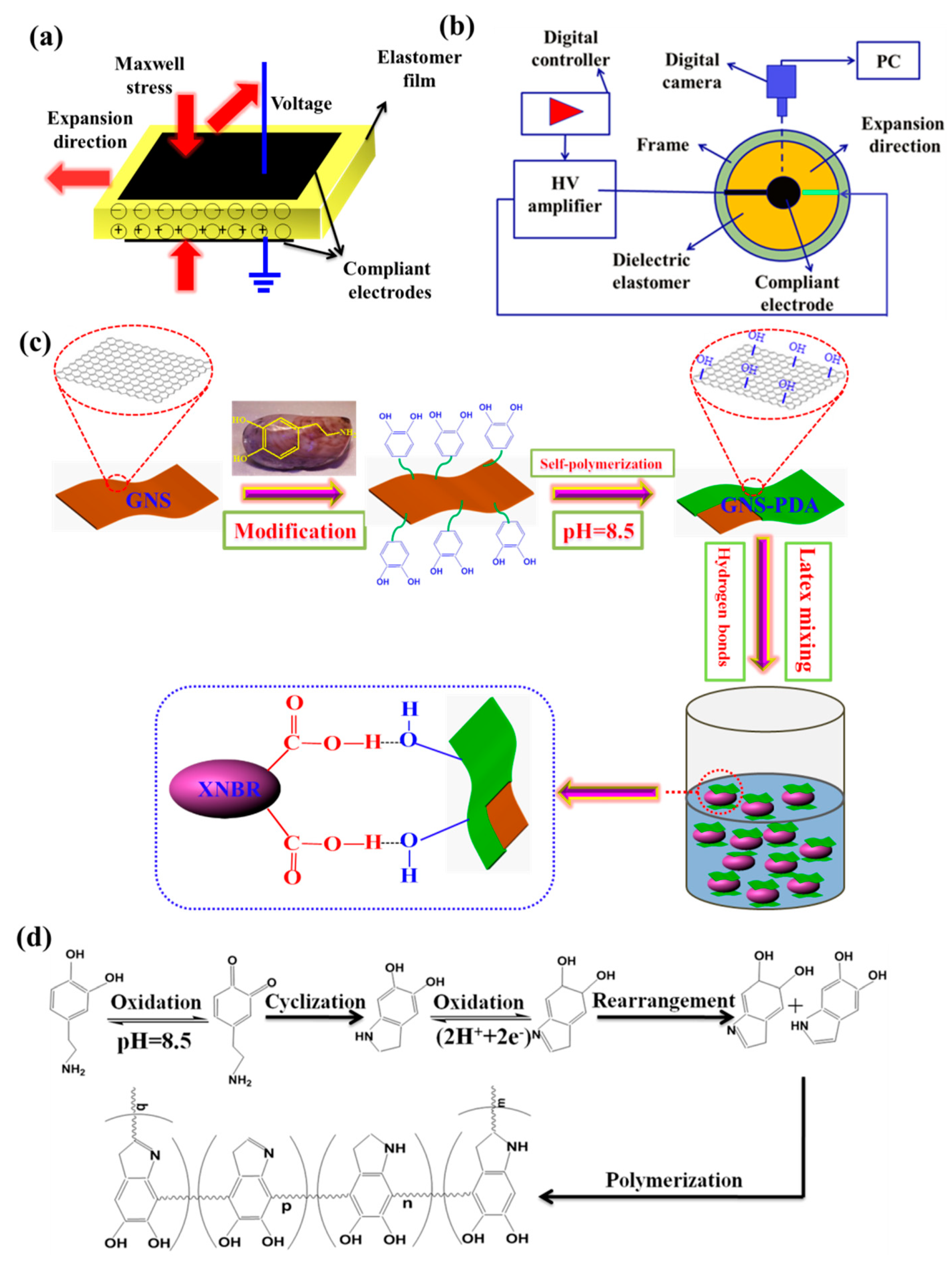
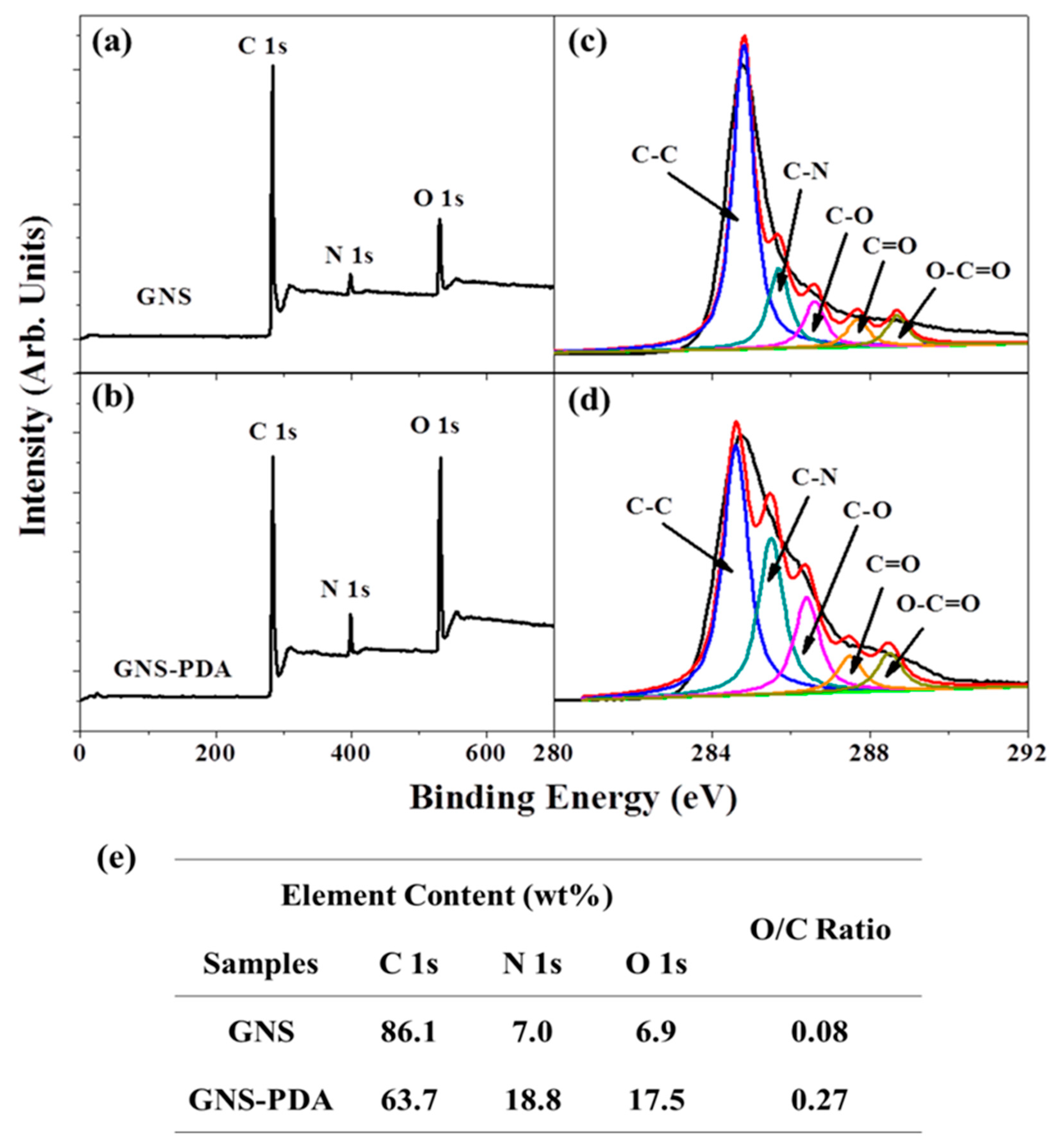
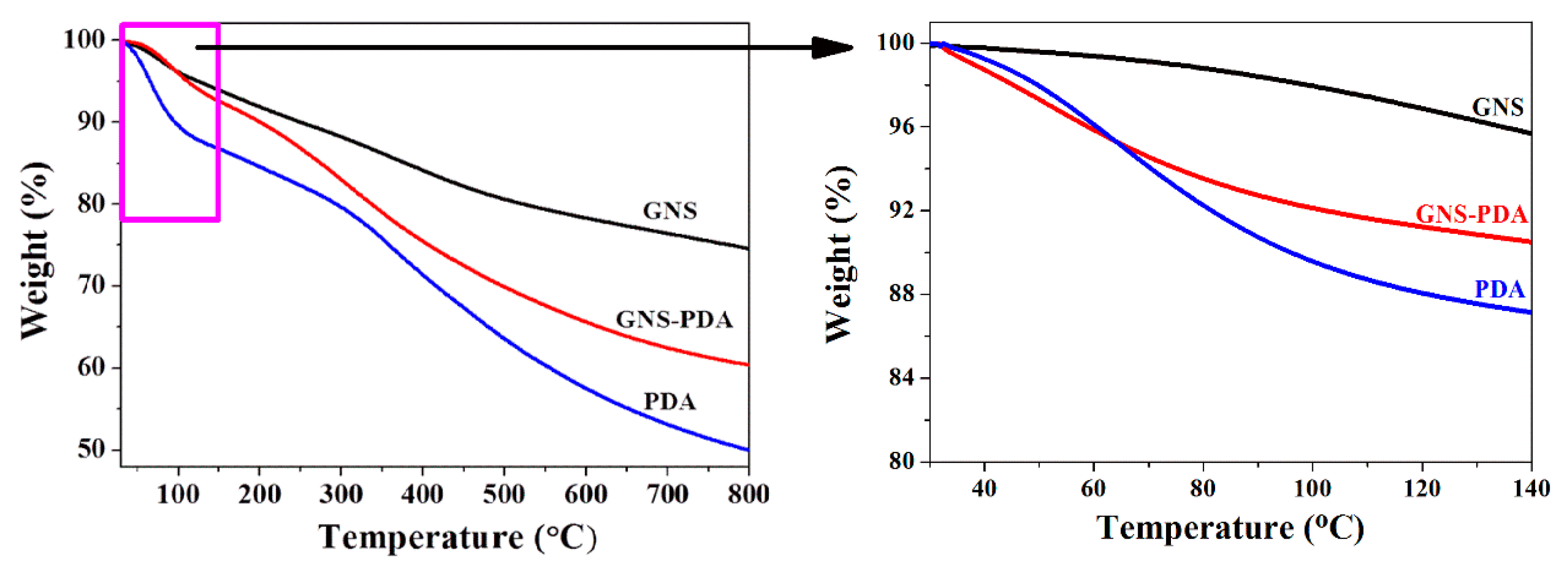
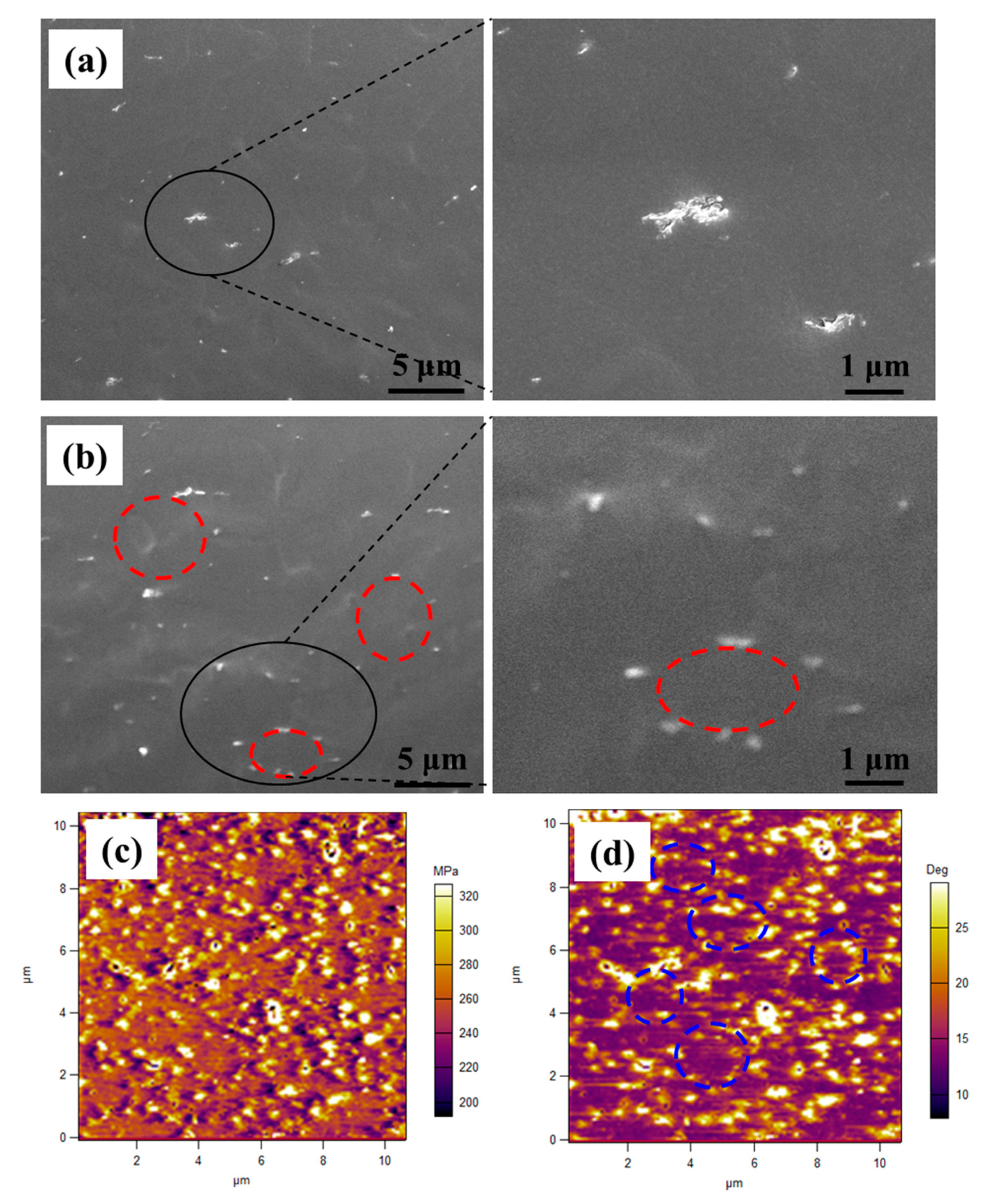
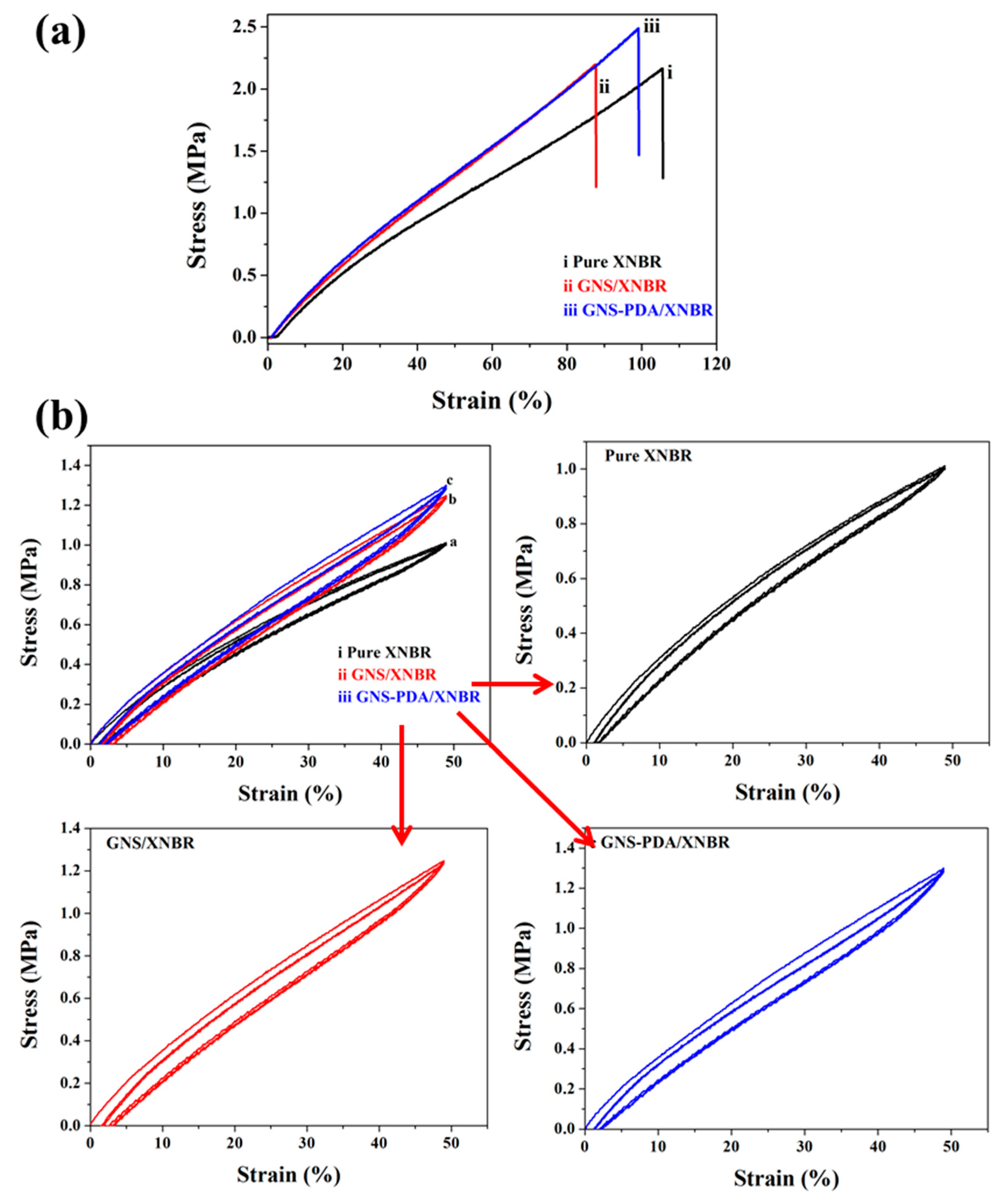
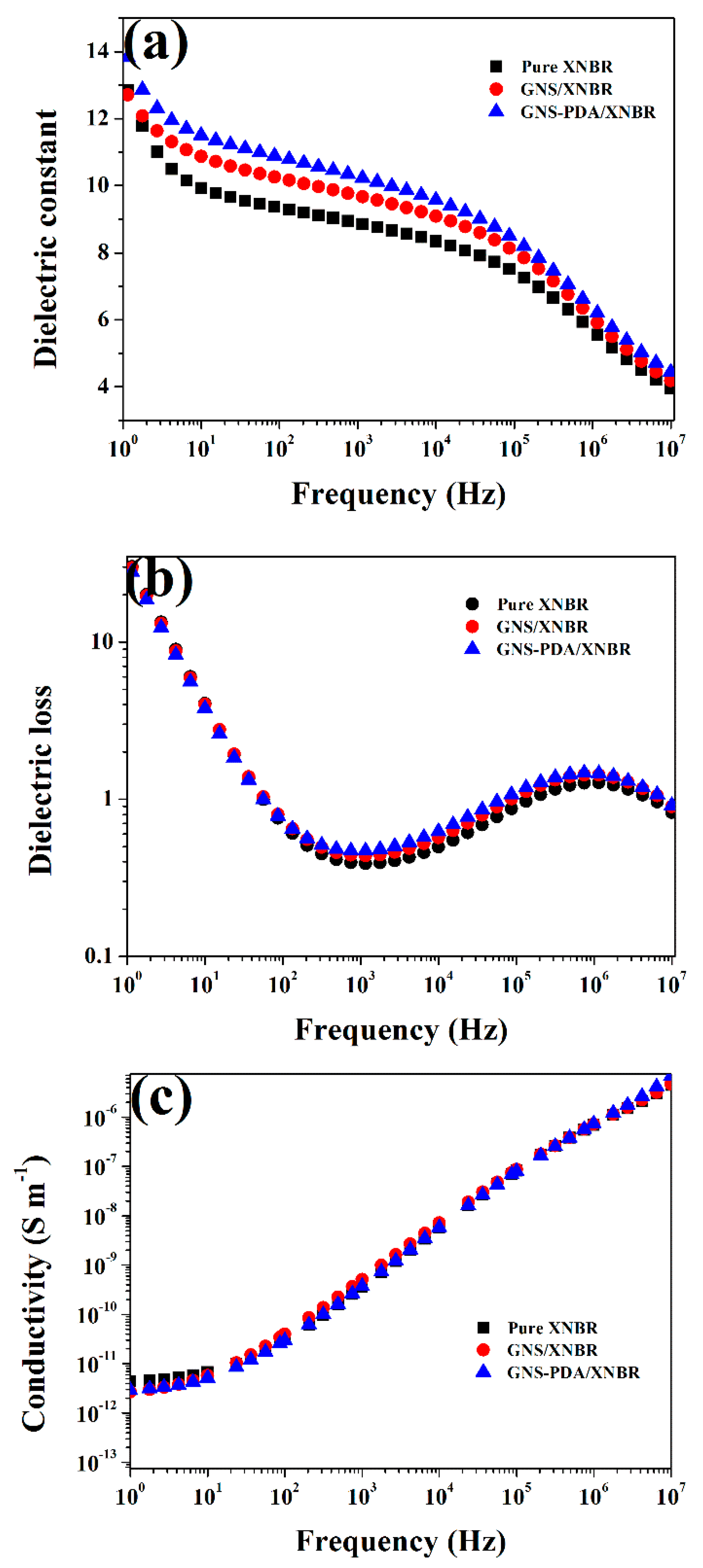
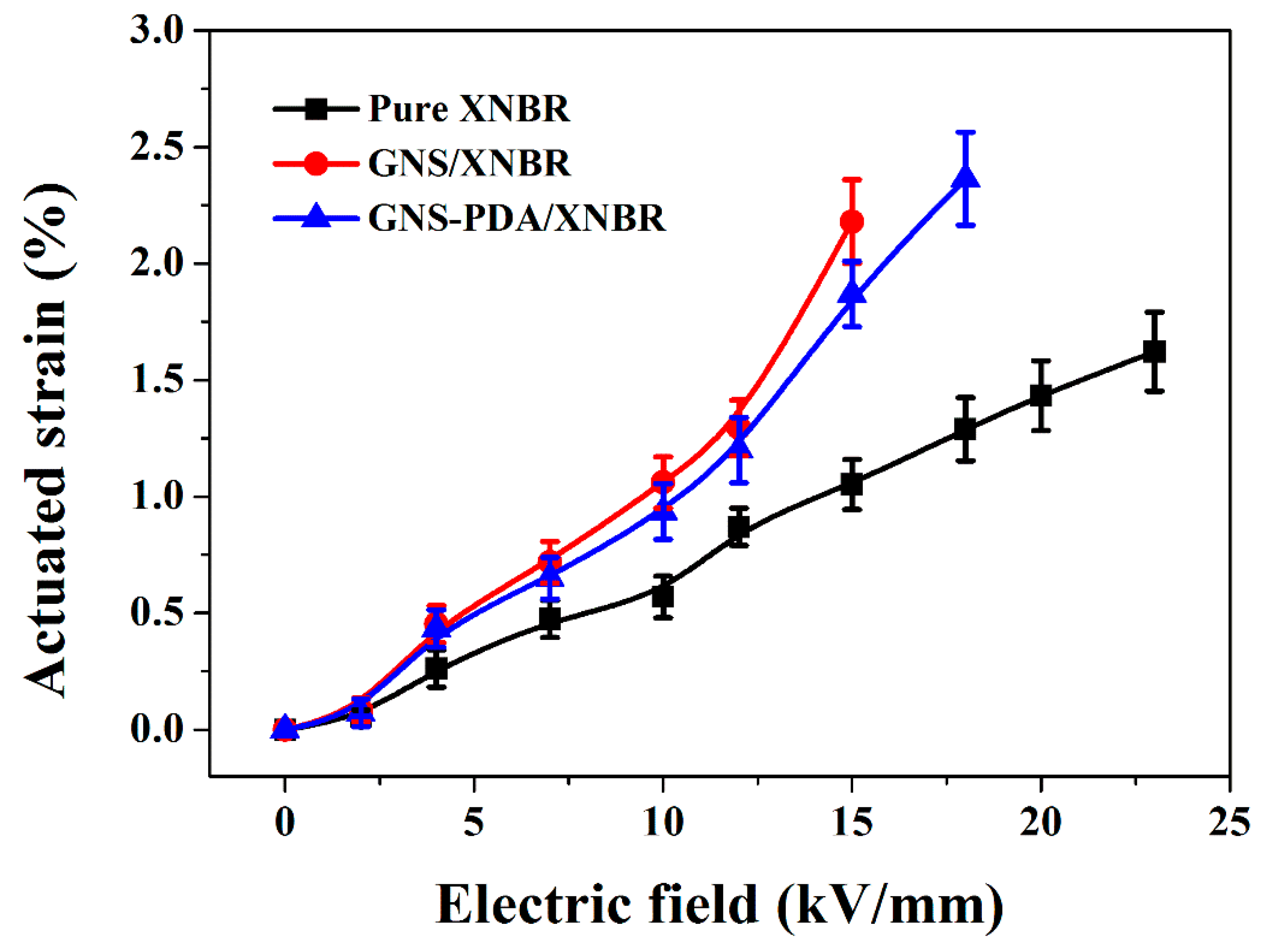
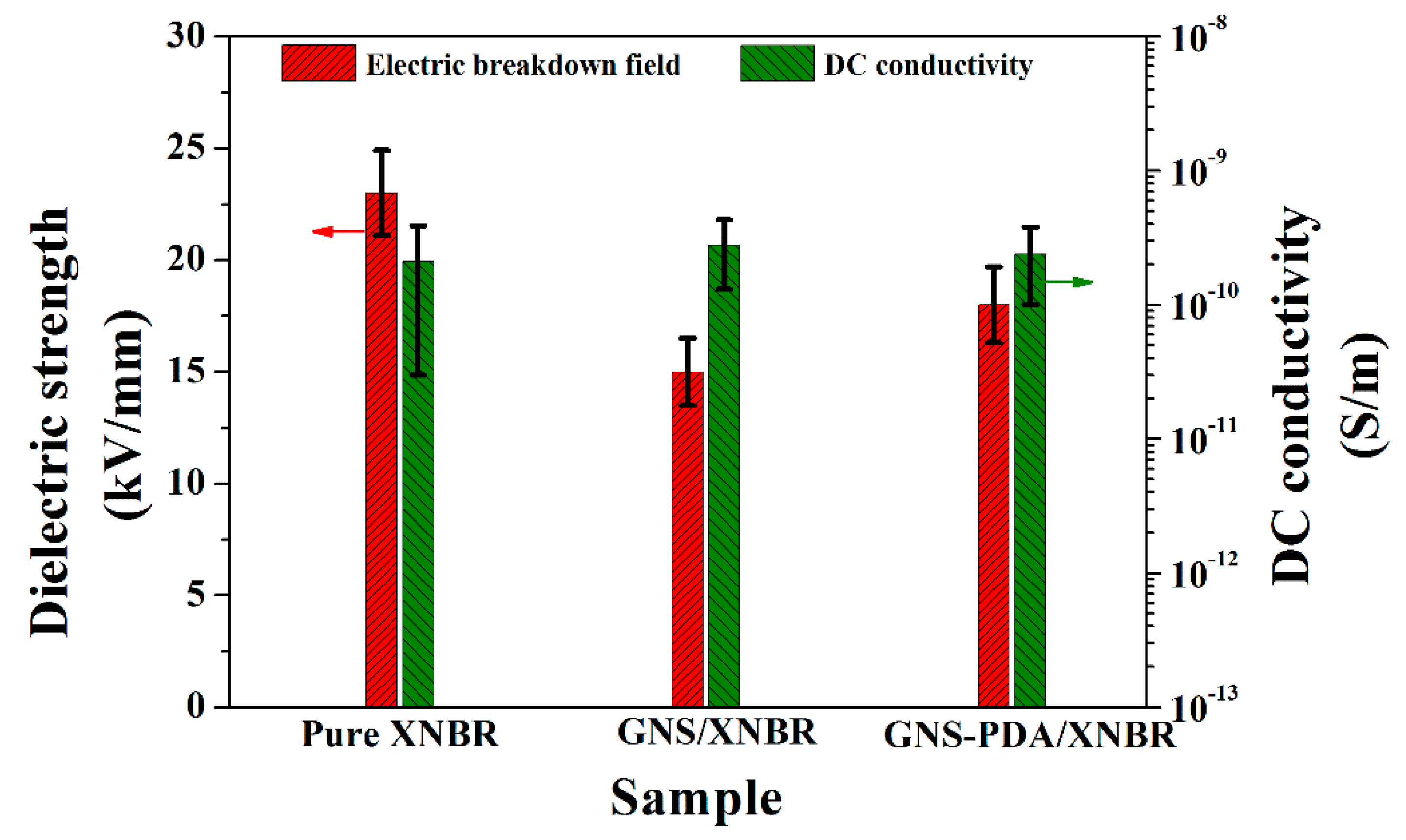
| Sample | Dielectric Constant (100 Hz) | Dielectric Loss (100 Hz) | AC Conductivity (10−11 S/m 100 Hz) | Elastic Modulus (MPa) | β (MPa−1) | DC Conductivity (10−10 S/m) | Maximum Strain (%) | Breakdown Strength (kV/mm) |
|---|---|---|---|---|---|---|---|---|
| Pure XNBR | 8.88 ± 0.14 | 0.606 ± 0.0051 | 3.06 ± 1.2 | 3.02 ± 0.19 | 2.94 | 2.1 ± 1.8 | 1.62 ± 0.17 | 23 ± 1.91 |
| GNS/XNBR | 10.15 ± 0.12 | 0.651 ± 0.0062 | 4.02 ± 1.6 | 3.34 ± 0.16 | 3.04 | 2.8 ± 1.5 | 2.18 ± 0.18 | 15 ± 1.53 |
| GNS-PDA/XNBR | 10.78 ± 0.11 | 0.647 ± 0.0056 | 3.17 ± 1.1 | 3.63 ± 0.14 | 2.97 | 2.4 ± 1.4 | 2.36 ± 0.20 | 18 ± 1.72 |
© 2019 by the authors. Licensee MDPI, Basel, Switzerland. This article is an open access article distributed under the terms and conditions of the Creative Commons Attribution (CC BY) license (http://creativecommons.org/licenses/by/4.0/).
Share and Cite
Yang, D.; Kong, X.; Ni, Y.; Ruan, M.; Huang, S.; Shao, P.; Guo, W.; Zhang, L. Improved Mechanical and Electrochemical Properties of XNBR Dielectric Elastomer Actuator by Poly(dopamine) Functionalized Graphene Nano-Sheets. Polymers 2019, 11, 218. https://doi.org/10.3390/polym11020218
Yang D, Kong X, Ni Y, Ruan M, Huang S, Shao P, Guo W, Zhang L. Improved Mechanical and Electrochemical Properties of XNBR Dielectric Elastomer Actuator by Poly(dopamine) Functionalized Graphene Nano-Sheets. Polymers. 2019; 11(2):218. https://doi.org/10.3390/polym11020218
Chicago/Turabian StyleYang, Dan, Xinxin Kong, Yufeng Ni, Mengnan Ruan, Shuo Huang, Puzhen Shao, Wenli Guo, and Liqun Zhang. 2019. "Improved Mechanical and Electrochemical Properties of XNBR Dielectric Elastomer Actuator by Poly(dopamine) Functionalized Graphene Nano-Sheets" Polymers 11, no. 2: 218. https://doi.org/10.3390/polym11020218
APA StyleYang, D., Kong, X., Ni, Y., Ruan, M., Huang, S., Shao, P., Guo, W., & Zhang, L. (2019). Improved Mechanical and Electrochemical Properties of XNBR Dielectric Elastomer Actuator by Poly(dopamine) Functionalized Graphene Nano-Sheets. Polymers, 11(2), 218. https://doi.org/10.3390/polym11020218







